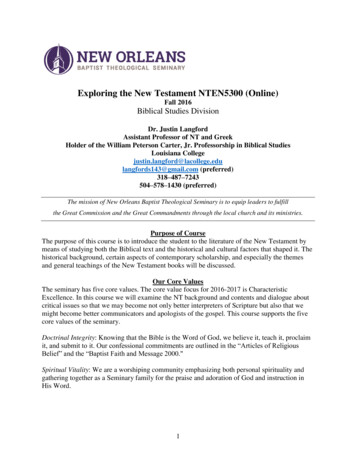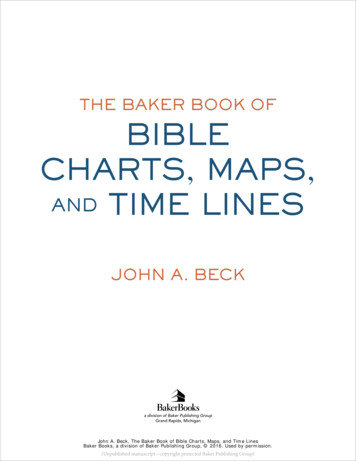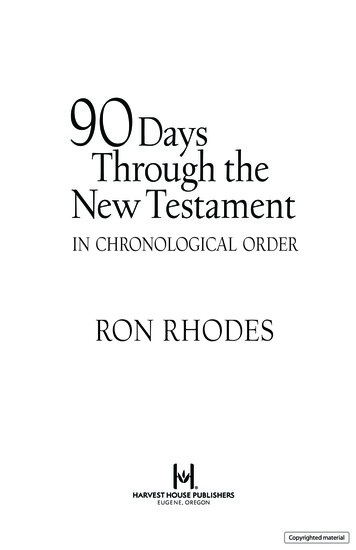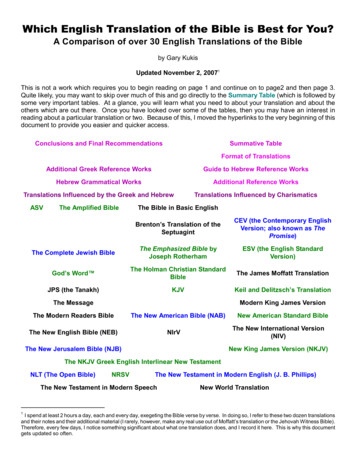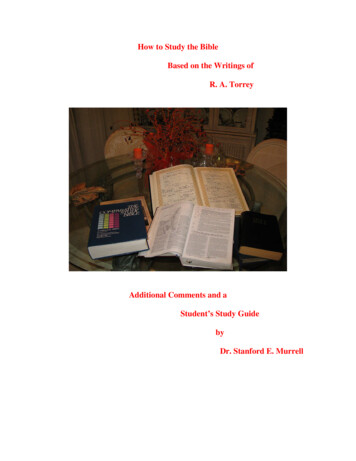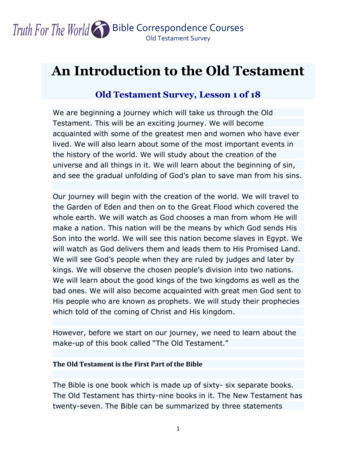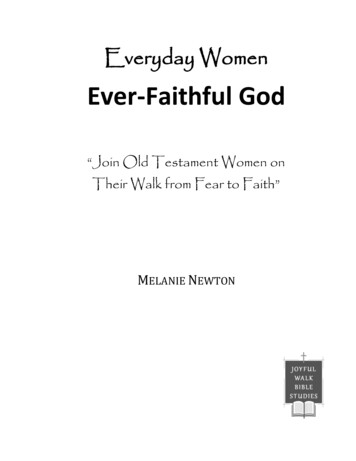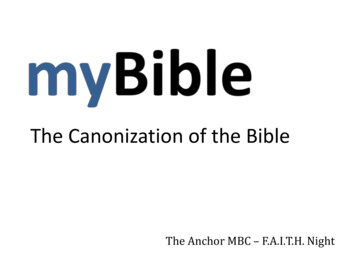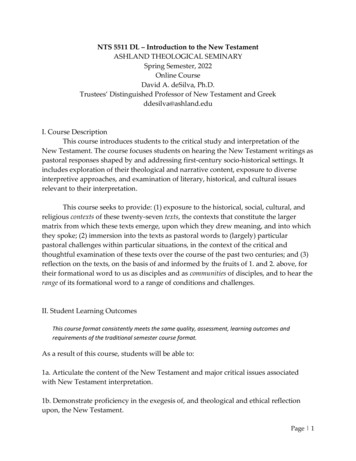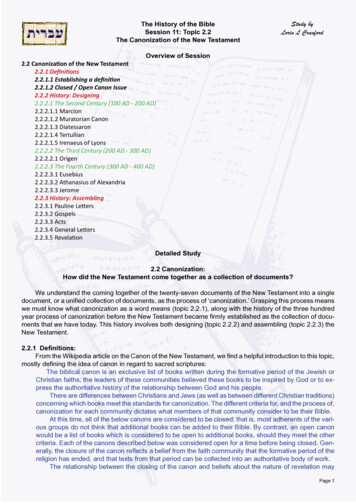
Transcription
The History of the BibleSession 11: Topic 2.2The Canonization of the New TestamentStudy byLorin L CranfordOverview of Session2.2 Canonization of the New Testament2.2.1 Definitions2.2.1.1 Establishing a definition2.2.1.2 Closed / Open Canon Issue2.2.2 History: Designing2.2.2.1 The Second Century (100 AD - 200 AD)2.2.2.1.1 Marcion2.2.2.1.2 Muratorian Canon2.2.2.1.3 Diatessaron2.2.2.1.4 Tertullian2.2.2.1.5 Irenaeus of Lyons2.2.2.2 The Third Century (200 AD - 300 AD)2.2.2.2.1 Origen2.2.2.3 The Fourth Century (300 AD - 400 AD)2.2.2.3.1 Eusebius2.2.2.3.2 Athanasius of Alexandria2.2.2.3.3 Jerome2.2.3 History: Assembling2.2.3.1 Pauline Letters2.2.3.2 Gospels2.2.3.3 Acts2.2.3.4 General Letters2.2.3.5 RevelationDetailed Study2.2 Canonization:How did the New Testament come together as a collection of documents?We understand the coming together of the twenty-seven documents of the New Testament into a singledocument, or a unified collection of documents, as the process of ‘canonization.’ Grasping this process meanswe must know what canonization as a word means (topic 2.2.1), along with the history of the three hundredyear process of canonization before the New Testament became firmly established as the collection of documents that we have today. This history involves both designing (topic 2.2.2) and assembling (topic 2.2.3) theNew Testament.2.2.1 Definitions:From the Wikipedia article on the Canon of the New Testament, we find a helpful introduction to this topic,mostly defining the idea of canon in regard to sacred scriptures:The biblical canon is an exclusive list of books written during the formative period of the Jewish orChristian faiths; the leaders of these communities believed these books to be inspired by God or to express the authoritative history of the relationship between God and his people.There are differences between Christians and Jews (as well as between different Christian traditions)concerning which books meet the standards for canonization. The different criteria for, and the process of,canonization for each community dictates what members of that community consider to be their Bible.At this time, all of the below canons are considered to be closed; that is, most adherents of the various groups do not think that additional books can be added to their Bible. By contrast, an open canonwould be a list of books which is considered to be open to additional books, should they meet the othercriteria. Each of the canons described below was considered open for a time before being closed. Generally, the closure of the canon reflects a belief from the faith community that the formative period of thereligion has ended, and that texts from that period can be collected into an authoritative body of work.The relationship between the closing of the canon and beliefs about the nature of revelation mayPage 1
be subject to different interpretations. Some believe that the closing of the canon signals the end of aperiod of divine revelation; others believe that revelation continues even after the canon is closed, eitherthrough individuals or through the leadership of a divinely sanctioned religious institution. Among thosewho believe that revelation continues after the canon is closed, there is further debate about what kindsof revelation is possible, and whether the revelation can add to established theology.A canonical text is a single authoritative text for each of the books in the canon, one which dependson editorial selections from among manuscript traditions with varying interdependence. Significant separate manuscript traditions in the canonical Hebrew Bible are represented in the Septuagint and its variations from the Masoretic text, which itself was established through the Masoretes’ scholarly collation ofvarying manuscripts, and in the independent manuscript traditions represented by the Dead Sea scrolls.Additional and otherwise unrecorded texts for Genesis and the early chapters of Exodus lie behind theBook of Jubilees. These manuscript traditions attest that even canonical Hebrew texts did not possessany single authorized manuscript tradition in the 1st millennium BC.New Testament Greek and Latin texts presented enough significant differences that a manuscripttradition arose of presenting diglot texts, with Greek and Latin on facing pages. New Testament manuscripttraditions include the Codex Vaticanus, Codex Sinaiticus, Codex Bezae, Textus Receptus, Vulgate, andothers.2.2.1.1 Establishing a definitionFrom the above article, one can understand ‘canon’ as the authoritative list of writings regarded as sacredscripture. The origin of the English word1 with this particular meaning is from the Greek word kanwvn (kanon),meaning ‘rule,’ ‘principle,’ among many others. Oftentimes one reads ‘canon list’ meaning a listing of authoritative writings. Also the ‘canon of the New Testament’ simply designates the list of documents understoodto properly belong to the Christian scriptures of the New Testament. For the beginning student of the Bible,this terminology is perhaps completely new and unfamiliar. For those who have worked in this field of biblicalstudies for any length of time, the terms are familiar and well understood.The definition of the word then is understandable: the canon of the New Testament simply designates thelist of documents that are properly included in the New Testament. These documents are included becausethey are considered sacred scripture as divinely inspired writings.The question arises then, ‘Who’s list?’ Fortunately within the vast array of Christian traditions very littlevariation of listing exists. The vast majority of Christian groups have in one way or another adopted the ratheruniversal list of twenty-seven documents as its official New Testament.Baptists have uniformly adopted the standard canon list from the earliest times. The Philadelphia Confession of Faith in 1742 listed the books of the Bible considered canonical. The earlier London Baptist Confession in 1689 had set the pattern for British Baptists, and was then followed by the American Baptist traditionbeginning with the Philadelphia Confession. Baptist since these earliest days have uniformly followed thispattern with their official declarations of what constitute Holy Scriptures.2.2.1.2 Closed / Open Canon IssueFrom the earliest of times the issue of the canon limits has been discussed and debated. As the belowhistory outlines, the second through the fifth centuries was largely the era of canon development. With thelarge number of documents floating around during the period claiming authoritative status, various Christiangroups had to make choices of which document or set of documents to decide upon as authoritative.Merriam-Webster online Dictionary:1can·on: Pronunciation: \ka-nən\ Function: nounEtymology: Middle English, from Old English, from Late Latin, from Latin, ruler, rule, model, standard, from GreekkanōnDate: before 12th century1 a: a regulation or dogma decreed by a church council b: a provision of canon law2 [Middle English, from Anglo-French, from Late Latin, from Latin, model] : the most solemn and unvarying part of theMass including the consecration of the bread and wine3 [Middle English, from Late Latin, from Latin, standard] a: an authoritative list of books accepted as Holy Scripture b:the authentic works of a writer c: a sanctioned or accepted group or body of related works the canon of great literature 4 a: an accepted principle or rule b: a criterion or standard of judgment c: a body of principles, rules, standards, ornorms5 [Late Greek kanōn, from Greek, model] : a contrapuntal musical composition in which each successively entering voicepresents the initial theme usually transformed in a strictly consistent way1Page 2
From the time of the Latin Vulgate in the early fifth century on the issue of the Bible was a closed discussion. The canon became fixed by 500 AD, that is, it became a ‘closed canon.’ The issue was a ‘non-issue’and thus raised little or no discussion until the Protestant Reformation in the 1500s. Martin Luther rejectedthe Apocrypha as sacred scripture for the canon of the Old Testament. Additionally, he questioned the levelof usefulness of some of the writings in the New Testament. Using a modified pattern from both Origen inthe third century and Eusebius in the fourth century, he created the concept of a ‘canon within the canon.’For him, along with the other reformers -- John Calvin and Ulrich Zwingli -- as well, the canon of scripturewas closed, and excluded the Apocrypha from the Old Testament. The NT writings of Hebrews, James, Judeand Revelation tended to be regarded as less valuable sources of divine insight and thus were reduced toa secondary status inside the canon of the New Testament. Thus for the next two to three centuries thesedocuments functioned somewhat as an appendix to the rest of the New Testament documents. But beginningin the 1900s this patterned shifted with the rather universal adoption of all twenty-seven documents listed inthe sequential order going back to that of Athanasisus in 367 AD.2Historic Christianity3 in both Eastern Orthodoxy, and western Christianity in Roman Catholicism and Protestantism today uniformly understand the canon of the Bible to be closed, that is, fixed and unchangeable.Only cult groups with some attempted identification with Christianity such as the Mormon Church, ChristianScience etc. claim an open canon. This is a matter of convenience in order to give credibility to writings suchas the Book of Mormon, Science and Health with Key to the Scriptures by Mary Baker Eddy. Christianityanchored to the Bible has vigorously rejected as false these aberrations from historical Christian belief. Oneof the arguments used against the cultic groups is the concept of a closed canon reaching back to the earlychurch in regard to the New Testament, and to the Hebrew scriptures for the Old Testament.2.2.2 History of the Process: Designing the VehicleWhen we begin thinking about the canon of the New Testament, we need to think in terms of a severalcenturies long process in which early Christians increasingly gained access to various writings that couldbecome sources of insight into what Christians were supposed to believe and how they should behave themselves in daily living. A part of the challenge was to distinguish which (1) writings should possess high authorityand be regarded as sacred scripture, and (2) those which might offer some helpful insight but should not beconsidered as inspired scripture. Additionally, (3) a third category of writings presented the greatest challenge:those which should be considered dangerous because they taught false ideas about Christianity and could leadChristians into heresy, both in belief and practice. Because various Christian communities were scattered allover the Mediterranean world, different conclusions about these issues naturally developed. As time passeddifferent lists of authoritative writings would surface. But gradually a common listing began appearing until itbecame rather universally adopted by the fourth century.Many of the writings (3) that were used but gradually fell by the wayside with a “heresy” label are knowntoday as the New Testament Apocrypha. Only in the last century have manuscripts of these documents surfaced with archaeological discoveries. Previously most of what we knew about them came from criticisms ofthem by the Church Fathers.The middle group (2) which were often considered of great value but not to be regarded as sacred scripture include first the writings of the Apostolic Fathers. These individuals lived and worked in the first half ofthe second Christian century. These individuals and writings include the Didache, the writings of Clement ofRome (2 letters), Ignatius of Antioch (7 short letters), Polycarp of Smyrna (2 documents -- one by him and oneabout his martyrdom), the Shepherd of Hermas, as well as some fragments of a few other Christian leaders.In some Christian circles toward the end of the second century and well into the third century, some of thesewritings show up on canon lists, while some of the 27 documents in our New Testament do not appear.The later groups of the Church Fathers -- the Apologists in the late second and third century; the Latinand Greek Fathers; and other categories -- produced many writings that helped shape the idea of the canonof the New Testament in these early centuries.Two individuals played an important role at the end of this period in helping settle this issue for mostChristians. In 367 AD, Athanasius of Alexandria Egypt issued an Easter Letter to the churches in that part ofthe world with instructions etc. In this letter he lists the authoritative scriptures that were commonly acceptedFor a tabular listing of the canonical books of the Bible by different Christian traditions, see “Books ofthe Bible” in Wikipedia.com.3“Nonetheless, a full dogmatic articulation of the canon was not made until the Council of Trent of 1546for Roman Catholicism,[30] the Thirty-Nine Articles of 1563 for the Church of England, the Westminster Confession of Faith of 1647 for British Calvinism, and the Synod of Jerusalem of 1672 for the Greek Orthodox”[“Canon of the Bible,” Wikipedia online].2Page 3
by Christians generally and that should be exclusively used as scripture by Christians in Egypt and NorthAfrica. It lists the same 27 books that compose the canon of the New Testament universally adopted todayamong Christians. Next came the work of Jerome in translating both the Old and New Testaments into Latin,this translation came to be known as the Vulgate. Jerome adopted the list of Athanasius for the New Testament. He began this work in 382 AD and completed it in 405 AD. Athanasius as a leader of Eastern Christianityhelped close the issue of canon for the New Testament in that tradition. Jerome’s Vulgate pretty much settledthe issue for Western Christianity.The only variation from this listing of 27 documents has been the Syrian Orthodox Church, which has hadtrouble accepting the 2 Peter, 2 - 3 John, Jude and the Book of Revelation growing out of its use of the Peshitta,a Syriac translation dating back to the early 400s. Modern Syriac Christian translations usually contain thesewritings based on a seventh century translation. They held for a long time to the idea of a three fold generalletters section -- James - 1 Peter -- 1 John. This was widely adopted early on, but gradually was expandedby most Christian groups into a seven fold section with the addition of 2 Peter, 2-3 John, and Jude. Adoptionof this seven fold general letters section came much slower for Syrian Christians.For Christians in the West, this list of 27 documents has continued to be regarded as the scripture of theNew Testament. The Council of Trent (1545) made this list official for Roman Catholics. Protestant Christians,especially Martin Luther, pretty much accepted this list of 27 documents. But for Luther a struggle developednot about whether the 27 documents should be considered scripture or not. Rather, he went back to the ChurchFather Origen in the third century AD and found a basis for adopting a “Canon within the Canon” listing. Heproposed differing levels of canonicity inside the New Testament canon, largely based on how strongly eachdocument stressed “justification by faith in Christ,” as is described below:Initially Luther had a low view of the books of Esther, Hebrews, James, Jude, and Revelation. Hecalled the Epistle of James “an epistle of straw,” finding little in it that pointed to Christ and His savingwork. He also had harsh words for the book of Revelation, saying that he could “in no way detect thatthe Holy Spirit produced it.”[3] He had reason to question the apostolicity of Hebrews, James, Jude, andRevelation because the early church categorized these books as antilegomena, meaning that they werenot accepted without reservation as canonical. Luther did not, however, remove them from his editionsof the Scriptures. His views on some of these books changed in later years.Luther chose to place in the Apocrypha, an inter-testamental section of his bible, those portions of theOld Testament found in the Greek Septuagint but not in the Hebrew Masoretic text. These were includedin his earliest translation, but were later set aside as “good to read” but not as the inspired Word of God.The setting aside (or simple exclusion) of these texts in/from Bibles was eventually adopted by nearly allProtestants (See Biblical canon).This listing of some books more as an appendix at the back of the Luther Bibel continued until the 1904revision, which then shifted them to the standard sequential listing found in other translations. It’s easy tocriticize Luther at this point. But I have challenged preachers over the past 40 years to take a look at theirsermon files. Very few preachers have preached sermons from all 27 documents in the New Testament. Mosthave concentrated their preaching and teaching ministry on a dozen or so of the 27 books of the New Testament. While we would not openly adopt Luther’s position on a “Canon within the Canon” the reality is that ouractual “canon of the New Testament” is those parts of the New Testament that we teach and preach from.From a Roman Catholic perspective, George J. Reid (Catholic Encyclopedia) provides a very accurateand helpful summary:The idea of a complete and clear cut canon of the New Testament existing from the beginning, thatis from Apostolic times, has no foundation in history. The Canon of the New Testament, like that of theOld, is the result of a development, of a process at once stimulated by disputes with doubters, both withinand without the Church, and retarded by certain obscurities and natural hesitations, and which did notreach its final term [in Roman Catholic circles] until the dogmatic definition of the Tridentine Council [13December, 1545].Most Christian groups today would regard the canon of the Bible as “closed.” That is, God in His providence has guided us into the listing of all the documents that Christians should regard as sacred scripture.Some cultic groups down the way have taken the view that the canon is still “open” to the addition of moredocuments to be regarded as sacred scripture at some level. The Mormons have the Book of Mormon; Christian Scientists have the writings of Mary Baker Eddy.2.2.2.1 The second Christian century (100 to 200 AD)The key individuals etc. for the second Christian century that played important roles in the canonization ofthe New Testament are Marcion, the Muratorian fragment, the Diatessaron, Tertullian and Irenaeus of Lyons.Page 4
Other writings and church fathers will contribute to the discussion as well during this era.Although it is not completely clear how the dynamics worked, a major impetus that propelled the processof canonization came from a renegade Christian leader on the Italian peninsula, Marcion of Sinope. His radicalapproach to a canon of New Testament scriptures coupled with an equally radical view of Christianity causeda stiff reaction from more traditional Christian leaders. The booming success of Maricon’s movement on theItalian peninsula in quickly coming to dominate the Christian communities there forced reaction and criticismof him. Just how widely the written NT documents were being used in Christian communities around theMediterranean world is not real clear. But a wide variety of Christian writings beyond those in our New Testament were produced during this second century. Most of these were coming either from Christian leaders ofdifferent movements or else from unnamed members of many of these movements who wrote and attachedthe name of a first century leader to the document in order to gain credibility for their writing. Many of thesewritings now fall under the label New Testament Apocrypha; English translations of most of these documentsare now available through the internet for those desiring to read the contents and read about the documents.Thus some of the movement toward a canon in the second century was reactionary and was driven by hostileforces. When one comes to the late second century fathers of Tertullian and Irenaeus, the pattern is still toassert what is authoritative over against what is heretical and should be rejected. Not until the third centurydoes a less emotional approach become more common in these discussions.2.2.2.1.1 Marcion, (ca. 150 AD)This summary from the Wikipedia article on the “Biblical canon” offers a helpful overview:Marcion of Sinope: c. 150, was the first of record to propose a definitive, exclusive,unique canon of Christian scriptures. (Though Ignatius did address Christian scripture,before Marcion, against the heresies of the Judaizers and Dociests, he did not publisha canon.) Marcion rejected the theology of the Old Testament, which he claimed wasincompatible with the teaching of Jesus regarding God and morality. The Gospel of Luke,which Marcion called simply the Gospel of the Lord, he edited to remove any passagesthat connected Jesus with the Old Testament. This was because he believed that the godof the Jews, YHWH, who gave them the Jewish Scriptures, was an entirely different godthan the Supreme God who sent Jesus and inspired the New Testament. He used ten letters of Paul aswell (excluding Hebrews and the Pastoral epistles) assuming his Epistle to the Laodiceans referred tocanonical Ephesians and not the apocryphal Epistle to the Laodiceans or another text no longer extant.He also edited these in a similar way. To these, which he called the Gospel and the Apostolicon, he addedhis Antithesis which contrasted the New Testament view of God and morality with the Old Testament viewof God and morality. By editing he thought he was removing judaizing corruptions and recovering theoriginal inspired words of Jesus and Paul. Marcion’s canon and theology were rejected as heretical bythe early church; however, he forced other Christians to consider which texts were canonical and why.He spread his beliefs widely; they became known as Marcionism. Henry Wace in his introduction [4] of1911 stated: “A modern divine. . .could not refuse to discuss the question raised by Marcion, whetherthere is such opposition between different parts of what he regards as the word of God, that all cannotcome from the same author.” The Catholic Encyclopedia of 1913 stated: “they were perhaps the mostdangerous foe Christianity has ever known.” Adolf von Harnack in Origin of the New Testament [5], 1914,argued that Marcion viewed the church at this time as largely an Old Testament church (one that “follows the Testament of the Creator-God”) without a firmly established New Testament canon, and that itgradually formulated its New Testament canon in response to the challenge posed by Marcion.The precise impact of Marcion on the process of canonization of the New Testament is debated amongNew Testament scholars in modern times. The older view is that Marcion by his adoption of a splintered canontriggered the process of canonization by orthodox churches in reaction to his work. But increasingly this viewis questioned at the point of Marcion having played such a major role in this process. Most scholars todayunderstand the process as more complex than this, although Marcion was a factor he was only one of several dynamics moving Christianity in general toward a canon of New Testament scripture. I suspect modernscholarship is moving the right direction.2.2.2.1.2 Muratorian Canon, (ca. 170 AD)This summary from the Wikipedia article on the “Biblical canon” offers a helpful overview:Muratorian fragment [6]: this 7th century Latin manuscript is often considered to be a translation ofthe first non-Marcion New Testament canon, and dated at between 170 (based on an internal referenceto Pope Pius I and arguments put forth by Bruce Metzger) and as late as the end of the 4th century (acPage 5
cording to the Anchor Bible Dictionary[3]). This partial canon lists the four gospels and the letters of Paul,as well as two books of Revelation, one of John, another of Peter (the latter of which it notes is not oftenread in the churches). It rejects the Epistle to the Laodiceans and Epistle to the Alexandrians both saidto be forged in Paul’s name to support Marcionism.The fragmentary nature of the existing manuscripts of this ancient document limit its helpfulness.The fragment is a seventh-century Latin manuscript bound in an eighth or seventh century codex thatcame from the library of Columban’s monastery at Bobbio; it contains internal cues which suggest thatthe original was written about 170 (possibly in Greek), although some have regarded it as later. The copy“was made by an illiterate and careless scribe, and is full of blunders” (Henry Wace[1]). The poor Latinand the state that the original manuscript was in has made it difficult to translate. The fragment, of whichthe beginning is missing and which ends abruptly, is the remaining section of a list of all the works thatwere accepted as canonical by the churches known to its anonymous original compiler. It was discoveredin the Ambrosian Library in Milan by Father Ludovico Antonio Muratori (1672 – 1750), the most famousItalian historian of his generation, and published in 1740.[1]It provides some insight into the evolving process of canonization at the end of the second century. From thiswe are made aware of the widespread acceptance of four gospels, Acts, thirteen letters of Paul excludingHebrews, ‘two letters’ of John, but which two we’re not sure, Jude. The Apocalypse of Peter is clearly rejectedas having worthwhile spiritual value.Thus by the late second century Christian churches are forming a canon of New Testament scriptures,but this is ‘in process’ and far from settled.2.2.2.1.3 Diatessaron, (150 - 160 AD)This summary from the Wikipedia article on the “Biblical canon” offers a helpful overview:Diatessaron: c. 173, a one-volume harmony of the four Gospels, translated and compiled by Tatian the Assyrian into Syriac. In Syriac speakingchurches, it effectively served as the only New Testament scripture untilPaul’s letters were added during the 3rd century. Some believe that Acts wasalso used in Syrian churches alongside the Diatessaron, however, Eusebius’Ecclesiastical History 4.29.5 states: “They, indeed, use the Law and Prophets and Gospels, but interpret in their own way the utterances of the SacredScriptures. And they abuse Paul the apostle and reject his epistles, and do notaccept even the Acts of the Apostles.” (There were many books with the title of ‘Acts’, written about thesame time by different writers. Moreover, at one time the Gospel of Luke and the biblical ‘Acts’ appear tohave been one continuous document.) In the 4th century, the Doctrine of Addai lists a 17 book NT canonusing the Diatessaron and Acts and 15 Pauline epistles (including 3rd Corinthians). The Diatessaronwas eventually replaced in the 5th century by the Peshitta, which contains a translation of all the booksof the 27-book NT except for 2 John, 3 John, 2 Peter, Jude and Revelation and is the Bible of the SyriacOrthodox Church where some members believe it is the original New Testament, see Aramaic primacy.This document represents a failed effort to combine the four gospels into a single narrative. The importanceof this for our consideration of the canon is that time and divine providence convinced Christianity in generalof the value of the four separate stories of Jesus. In the Syriac speaking branch of early Christianity, severalattempts were made to alter the sources of Christian understanding, but without success.2.2.2.1.4 Tertullian, (ca 160 - 220 AD)This summary from the Wikipedia article on Tertullian provides some insight into his view of scripture inthe discussion about the regula fidei.5. With reference to the rule of faith, it may be said that Tertullian is constantlyusing this expression and by it means now the authoritative tradition handed downin the Church, now the Scriptures themselves, and perhaps also a definite doctrinalformula. While he nowhere gives a list of the books of Scripture, he divides them intotwo parts and calls them the instrumentum and testamentum (Adv. Marcionem, iv.1). He distinguishes between the four Gospels and insists upon their apostolic originas accrediting their authority (De praescriptione, xxxvi.; Adv. Marcionem, iv. 1-5); intrying to account for Marcion’s treatment of the Lucan Gospel and the Pauline writings he sarcastically queries whether the “shipmaster from Pontus” (Marcion) hadever been guilty of taking on contraband goods or tampering with them after theywere aboard (Adv. Marcionem, v. 1). The Scripture, the rule of faith, is for him fixed and authoritative (Decorona, iii.-iv.). As opposed to the pagan writings they are divine (De testimonio animae, vi.). They containPage 6
all truth (De praescriptione, vii., xiv.) and from them the Church drinks (potat) her faith (Adv. Praxeam, xiii.).The prophets were older than the Greek philosophers and their authority is accredited by the fulfilmentof their predictions (Apol., xix.-xx.). The Scriptures and the teachings of philosophy are incompatible, inso far as the latter are the origins of sub-Christian heresies. “What has Athens to do with Jerusalem?”he exclaims, “or the Academy with the Church?” (De praescriptione, vii.). Philosophy as pop-paganismis a work of demons (De anima, i.); the Scriptures contain the wisdom of heaven. However Tertullianwas not averse to using the technical methods of Stoicism to discuss a problem (De anima). The rule offaith, however, seems to be also applied by Tertullian to some distinct formula of doctrine, and he givesa succinct statement of the Christian faith under this term (De praescriptione, xiii.).One would need to clearly understand the distinction between Rule of Faith and scripture in Tertullian. The Ruleof Faith, reg
scripture. The origin of the English word1 with this particular meaning is from the Greek word kanwvn (kanon), meaning ‘rule,’ ‘principle,’ among many others. Oftentimes one reads ‘canon list’ meaning a listing of authori-tative writings. Also the ‘canon of the New Test
